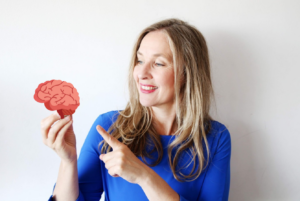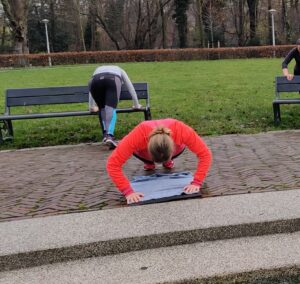By Sandra de Gelder
I have been exercising in one way or another for most of my life. As a child, I was taught and shown  the importance of training for my physical body and tried many different forms of sports, from tennis to jazz ballet, windsurfing and basketball. My parents made me always do at least one type of sport, and I have to admit I was never any good at any of them. On top of that, my brother was very talented and athletic, and I tended to feel inadequate in the sports arena.
the importance of training for my physical body and tried many different forms of sports, from tennis to jazz ballet, windsurfing and basketball. My parents made me always do at least one type of sport, and I have to admit I was never any good at any of them. On top of that, my brother was very talented and athletic, and I tended to feel inadequate in the sports arena.
All these things led to me never really liking training or exercising, and as an adult, it became a more difficult effort, and I had to find the motivation elsewhere. Group sports were never my thing, so I had to reach deep within to get myself moving. I tried with willpower, perseverance, determination, and discipline, but I always gave up after a short while. As if there was some kind of invisible blockage.
The mind as the key to workout success

I quickly learned that, like much in life, my state of mind determined my success or failure. My mind determined whether I trained, how hard I trained, how often I trained, and how long I kept on training. No matter how many goals I set for myself, I realized early on that even though my fitness goals transformed my body, it was in my mind where the key to my success was held. My mind was the one deciding whether I would quit or find the strength to keep going.
It wasn’t until I start learning about mindset, how the mind works and how it influences the body, that I came to understand that I could influence my initiative, progress, and the success of my exercise practice using the power of my mind and the thoughts I decided to think.
Let me explain.
Automatic thinking
Our brains carry thoughts along neural pathways. These pathways are like grooves that were created long ago and have been reinforced over time. If you always take the same route to work, you may notice that you can get there on “autopilot.” When we repeat a certain thought pattern many times, that neural pathway is reinforced, and the thinking becomes automatic. This causes us to act, speak, and think automatically or unconsciously.
Automatic thinking comes from our survival brain, the limbic system. It is constantly scanning the environment for threats. It has been protecting us and helping us survive throughout evolution. However, in the modern world, it can give rise to thoughts and actions that hurt us when it causes us to react in unhelpful ways, as these reactions are based on well-worn pathways to past and often outdated emotions or triggers.
Plastic brain
The good news is that we can build new pathways. Research conducted during the latter half of the 20th century showed that many aspects of the brain could be altered (or: are “plastic”) even throughout adulthood. This means that the brain can be rewired to function differently from how it previously functioned. It is called neuroplasticity.
So, in order to build up a fitness practice that supports my health goals, it was critical to become aware of the existing neural pathways and how they block me from achieving my training goals. For example, since I had never enjoyed sports much as a child, had never been any good at it compared to others and was mostly obliged to do it, the existing neural pathways interfered with my training goals by resistance and avoidance (the old story).
I realised that I needed to build awareness, mental strength, and agility to identify the automatic behaviour, find different options and consciously choose another route. Asking myself: What would I like to have happened? Where would I like to go? And then taking time and attention to consciously command my mind to take this new route.
In other words: create a new story. The brain, just like a muscle, learns by repetition, so once the decision was made it was a matter of sufficient repetition of this new story. Just like how you do not get a six-pack after doing just one plank, you do not sufficiently deepen a neural pathway by doing it just once.
Building new routes
So, understanding all that, I set off to change my mindset when it came to training by consciously commanding my mind and changing the outdated stories into new ones about how my body loved to exercise and how I was going to be proud and grateful for the results of training in terms of fitness, health and energy. I invested in a personal trainer (Lorna!), I trained every week, started doing yoga, and ran several times a week. I went from someone who never even thought she would be able to run for more than 100 meters to someone who ran the ‘Dam tot Dam loop’. Twice.
I had proven to myself that it is actually possible to develop and re-program the brain. With the same deliberateness that we strengthen certain muscles or fine-tune a movement, we can create neural pathways that better serve us and benefit our training practice and also our lives.
This is the essence of mental fitness training.
What is mental fitness?
As with physical fitness, mental fitness has far-reaching benefits. Most of us understand the importance of physical fitness. We have many options to develop it; with a trainer at the gym, at a HIIT class, or walking and running outside. We can choose our own set of activities to maintain the health and well-being of our body and develop muscles that help us function better in our day-to-day life. We become stronger and leaner, have more energy, endurance, and are less prone to accidents and injury. In other words: “we are fit.” Fit to respond to everyday demands like running for the tram or carrying heavy shopping bags, as well as fit to enjoy life, deal with stress, and attain a sense of achievement.
In much the same way, you can get similar benefits from developing your mental fitness. When your mind is “fit”, you have the capacity to handle life’s challenges with a more positive mindset and less stress.
Just as physical fitness provides you with an increased ability to respond to life with all of its ups and downs, mental fitness helps in the same way. It gives you more space to choose how to respond to a situation, whether that situation is anticipated, an external stimulus, or a feeling. As a result, you will be less likely to sustain (or cause) emotional and relational upset.
Interested in building your mental muscles?
I recently trained to become a mental fitness coach, helping people shift the balance in their minds and experience immediate and sustained improvements in both well-being and performance, using a well-researched, tried and tested methodology.
If you are looking for a way to boost your performance, improve your well-being and/or strengthen your relationships, I can help you.
Interested to find out more? Reach out at info@sandradegelder.com
The importance of mindset when it comes to exercise cannot be overstated. It all starts with the mind. If your mind is not in the game, then your performance, progress and well-being will suffer. It is worth investing in.
Author: Lorna Wilson
Like what you see? Then send me a message or e-mail. We can meet up for a chat and find out how I can help you improve your training and help reduce injury risk.
06 460 377 74 / lorna@wilsonsworkouts.nl






[…] you are currently training for a goal, here is a great blog by Sandra de Gelder about […]